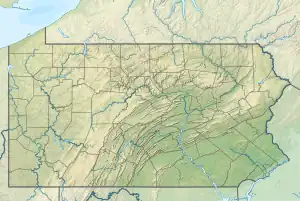| Paxton Creek | |
|---|---|
 View of Paxton Creek from Maclay Street in Harrisburg, Pennsylvania, near the Pennsylvania Farm Show. | |
 Location of the mouth of Paxton Creek in Pennsylvania | |
| Location | |
| Country | United States |
| State | Pennsylvania |
| County | Dauphin |
| Physical characteristics | |
| Source | |
| • location | Linglestown, Dauphin County, Pennsylvania |
| • coordinates | 40°21′29″N 76°48′9″W / 40.35806°N 76.80250°W[1] |
| • elevation | 1,220 ft (370 m)[2] |
| Mouth | Susquehanna River |
• location | Harrisburg, Dauphin County, Pennsylvania |
• coordinates | 40°14′35″N 76°51′50″W / 40.24306°N 76.86389°W[1] |
• elevation | 292 ft (89 m)[2] |
| Length | 13.9 mi (22.4 km)[3] |
| Basin size | 27.4 sq mi (71 km2)[2] |
| Basin features | |
| Tributaries | |
| • left | Black Run (Paxton Creek) |
| • right | Asylum Run |
Paxton Creek is a 13.9-mile-long (22.4 km)[3] tributary of the Susquehanna River in Dauphin County, Pennsylvania in the United States.

The Paxton Creek watershed covers an area of 27.4 square miles (71 km2) and joins the Susquehanna River at South Harrisburg, Harrisburg.[4]
The name Paxton, or Paxtang, is derived the Susquehannock term "Peshtank", meaning "where the waters stand" or "the place of springs". It is born from two branches on the southern slopes of Blue Mountain to form the main stem in Lower Paxton Township. It then forms Wildwood Lake in Susquehanna Township, artificially formed in 1908 by damming the creek for recreational activities.[5] Later, it extends downstream approximately 6.2 miles to Harrisburg as a concrete channel built in 1914 (against the wishes of Warren Manning) to mitigate urban runoff and flooding, which is common after severe storms. This urban stream section of the confluence has been subject to planned restoration efforts, with a 2018 study published by PennDOT stating a goal aiming to "restore the creek’s ecosystem and improve its functions and services" by reversing the negative effects of the concrete channel and its degradation.[6]
Where the stream passes through the city it receives the discharges from several large sewers, which, during dry weather, pollute the water and foul the shores and bottom of the creek to a very objectionable extent.
— Warren Manning, Proposed Municipal Improvements for Harrisburg, PA, 1901
Tributaries
See also
References
- 1 2 "Paxton Creek". Geographic Names Information System. 2008. Retrieved December 11, 2008.
- 1 2 3 Shaw, L. C.; W. F. Busch (June 1984). Pennsylvania Gazetteer of Streams, Part II. Water Resources Bulletin. Vol. 16. Prepared in Cooperation with the United States Department of the Interior Geological Survey. Harrisburg, PA: Pennsylvania Department of Forest and Waters. p. 226.
- 1 2 U.S. Geological Survey. National Hydrography Dataset high-resolution flowline data. The National Map, accessed August 8, 2011
- ↑ Paxton Creek Watershed and Education Association (2004). "Mission and History of PCWEA". paxtoncreek.org. Archived from the original on 2006-09-07. Retrieved 2006-12-23.
- ↑ "City of Harrisburg Comprehensive Plan 2020" (PDF). City of Harrisburg. p. 120. Retrieved 1 September 2021.
- ↑ "Paxton Creek Master Plan" (PDF). Plan the Keystone. February 21, 2018. Retrieved February 9, 2022.
External links





